Advances on Deflagration to Detonation Transition Methods in Pulse Detonation Engines
Abstract
1. Introduction
2. Hot Jet Ignition Initiation
3. Obstacle-Induced Detonation
3.1. Solid Obstacle-Induced Detonation
3.2. Fluidic Obstacle-Induced Detonation
4. Shock Wave Focusing Initiation
5. Plasma Ignition Initiation
6. Other DDT Methods
7. Conclusions
Author Contributions
Funding
Conflicts of Interest
References
- Liu, J.; Wang, Z.; Qin, W.; Li, J.; Zhang, Z.; Huang, J. Effects of detonation initial conditions on performance of pulse detonation chamber-axial turbine combined system. Energy 2023, 278, 127765. [Google Scholar] [CrossRef]
- Wei, L.; Wang, Z.; Qin, W.; Zhang, L. Numerical study on detonation initiation process in the chamber with characteristic structures of the dual-mode scramjet combustor. Proc. Inst. Mech. Eng. Part G J. Aerosp. Eng. 2023, 273, 701–713. [Google Scholar] [CrossRef]
- Wang, Z.; Wei, L.; Qin, W.; Liang, Z.; Zhang, K. Oxygen concentration distribution in a pulse detonation engine with nozzle-ejector combinational structures. Proc. Inst. Mech. Eng. Part G J. Aerosp. Eng. 2021, 235, 2059–2068. [Google Scholar] [CrossRef]
- Zhou, S.; Ma, Y.; Liu, F.; Hu, N. Experimental investigation on pulse operation characteristics of rotating detonation rocket engine. Fuel 2023, 354, 129408. [Google Scholar] [CrossRef]
- Roy, G.; Frolov, S.; Borisov, A.; Netzer, D. Pulse detonation propulsion: Challenges, current status, and future perspective. Prog. Energy Combust. Sci. 2004, 30, 545–672. [Google Scholar] [CrossRef]
- New, T.; Panicker, P.; Lu, F.; Tsai, H. Experimental investigations on DDT enhancements by schelkin spirals in a PDE. In Proceedings of the 44th AIAA Aerospace Sciences Meeting and Exhibit, Reno, NV, USA, 9–12 January 2006. [Google Scholar]
- Wang, Z.; Hui, Y.; Zhang, Y.; Xiao, J.; Qin, W.; Yang, Y. Numerical study of hydrogen ratio effect on detonation initiation characteristics of aviation kerosene with hydrogen addition. Aerosp. Sci. Technol. 2024, 152, 109353. [Google Scholar] [CrossRef]
- Ciccarelli, G.; Dorofeev, S. Flame acceleration and transition to detonation in ducts. Prog. Energy Combust. Sci. 2008, 34, 499–550. [Google Scholar] [CrossRef]
- Xiao, H.; Oran, E. Flame acceleration and deflagration-to-detonation transition in hydrogen-air mixture in a channel with an array of obstacles of different shapes. Combust. Flame 2020, 220, 378–393. [Google Scholar] [CrossRef]
- Hoke, J.; Bradley, R.; Schauer, F. Impact of DDT mechanism, combustion wave speed, temperature, and charge quality on pulsed-detonation-engine performance. In Proceedings of the 43rd AIAA Aerospace Sciences Meeting and Exhibit, Reno, NV, USA, 10–13 January 2005. [Google Scholar]
- Wang, Z.; Wei, L.; Li, H.; Pan, Z.; Huang, J.; Zhang, Y.; Liu, Z. Ignition energy effect on detonation initiation by single and two successive ignitions. Therm. Sci. 2020, 24, 4209–4220. [Google Scholar] [CrossRef]
- Meyer, T.; Hoke, J.; Brown, M.; Gord, J.; Schauer, F. Experimental study of deflagration-to-detonation enhancement techniques in a H2/air pulsed-detonation engine. In Proceedings of the 38th AIAA/ASME/SAE/ASEE Joint Propulsion Conference & Exhibit, Indianapolis, IN, USA, 7–10 July 2002. [Google Scholar]
- Chan, C. Collision of a shock wave with obstacles in a combustible Mixture. Combust. Flame 1995, 100, 341–348. [Google Scholar] [CrossRef]
- Lieberman, D.; Shepherd, J.; Wang, F.; Liu, J.; Gundersen, M. Characterization of a corona discharge initiator using detonation tube impulse measurements. In Proceedings of the 43rd AIAA Aerospace Sciences Meeting and Exhibit, Reno, NV, USA, 10–13 January 2005. [Google Scholar]
- Zhao, W.; Han, Q.; Zhang, Q. Experimental investigation on detonation initiation with a transversal flame jet. Combust. Explos. Shock Wave 2013, 49, 171–177. [Google Scholar] [CrossRef]
- Helman, D.; Shreeve, R.; Eidelman, S. Detonation pulse engine. In Proceedings of the 22nd AIAA/ASME/SAE/ASEE Joint Propulsion Conference, Huntsville, AL, USA, 16–18 June 1986. [Google Scholar]
- Brophy, C.; Netzer, D.; Forster, D. Detonation studies of JP-10 with oxygen and air for pulse detonation engine development. In Proceedings of the 34th AIAA/ASME/SAE/ASEE Joint Propulsion Conference and Exhibit, Cleveland, OH, USA, 13–15 July 1998. [Google Scholar]
- Shimada, H.; Kenmoku, Y.; Sato, H.; Hayashi, A. A new ignition system for pulse detonation engine. In Proceedings of the 42nd AIAA Aerospace Sciences Meeting and Exhibit, Reno, NV, USA, 5–8 January 2004. [Google Scholar]
- Lieberman, D.; Parkin, K.; Shepherd, J. Detonation initiation by a hot turbulent jet for use in pulse detonation engines. In Proceedings of the 38th AIAA/ASME/SAE/ASEE Joint Propulsion Conference & Exhibit, Indianapolis, IN, USA, 7–10 July 2002. [Google Scholar]
- Piton, D.; Prigent, A.; Serre, L.; Monjaret, C. Performance of a valveless air breathing pulse detonation engine. In Proceedings of the 40th AIAA/ASME/SAE/ASEE Joint Propulsion Conference and Exhibit, Fort Lauderdale, FL, USA, 11–14 July 2004. [Google Scholar]
- Wang, Z.; Zhang, Y.; Chen, X.; Liang, Z.; Zheng, L. Investigation of hot jet effect on detonation initiation characteristics. Combust. Sci. Technol. 2017, 189, 498–519. [Google Scholar] [CrossRef]
- Zheng, H.; Liu, S.; Zhao, N.; Chen, X.; Jia, X.; Li, Z. Numerical simulation of hot jet detonation with different ignition positions. Appl. Sci. 2019, 9, 4607. [Google Scholar] [CrossRef]
- Brophy, C.; Sinibaldi, J.; Damphousse, P. Initiator performance for liquid-fueled pulse detonation engines. In Proceedings of the 40th AIAA Aerospace Sciences Meeting and Exhibit, Reno, NV, USA, 14–17 January 2002. [Google Scholar]
- Brophy, C.; Werner, S.; Sinibaldi, J. Performance characterization of a valveless pulse detonation engine. In Proceedings of the 41st Aerospace Sciences Meeting and Exhibit, Reno, NV, USA, 6–9 January 2003. [Google Scholar]
- He, J.; Fan, W.; Chi, Y.; Zheng, J.; Zhang, W. A comparative study on millimeter-scale flame jet and detonation diffraction in a rectangular chamber. In Proceedings of the 21st AIAA International Space Planes and Hypersonics Technologies Conference, Xiamen, China, 6–9 March 2017. [Google Scholar]
- Wang, Z.; Zhang, Y.; Huang, J.; Liang, Z.; Zheng, L.; Lu, J. Ignition method effect on detonation initiation characteristics in a pulse detonation engine. Appl. Therm. Eng. 2016, 93, 1–7. [Google Scholar] [CrossRef]
- Cai, X.; Liang, J.; Lin, Z.; Deiterding, R.; Zhuang, F. Detonation initiation and propagation in nonuniform supersonic combustible mixtures. Combust. Sci. Technol. 2015, 187, 525–536. [Google Scholar] [CrossRef]
- Cai, X.; Chen, W.; Jin, K.; Deiterding, R.; Liang, J. An experimental study of detonation initiation in supersonic flow using a hot jet. Combust. Flame 2023, 249, 112613. [Google Scholar] [CrossRef]
- Chen, W.; Liang, J.; Cai, X.; Lin, Z. The initiation and propagation of detonation in supersonic combustible flow with boundary layer. Int. J. Hydrogen Energy 2018, 43, 12460–12472. [Google Scholar] [CrossRef]
- Chen, W.; Liang, J.; Cai, X.; Mahmoudi, Y. Three-dimensional simulations of detonation propagation in circular tubes: Effects of jet initiation and wall reflection. Phys. Fluids 2020, 32, 046104. [Google Scholar] [CrossRef]
- Wang, Y.; Liang, J.; Deiterding, R.; Cai, X.; Zhang, L. A numerical study of the rapid deflagration-to-detonation transition. Phys. Fluids 2022, 34, 117124. [Google Scholar] [CrossRef]
- Wang, Z.; Qin, W.; Huang, J.; Wei, L.; Yang, Y.; Wang, Y.; Zhang, Y. Numerical investigation of the effect of jet intensity from internal jet tube on detonation initiation characteristics. Int. J. Hydrogen Energy 2022, 47, 13732–13745. [Google Scholar] [CrossRef]
- Wang, Z.; Xiao, J.; Zhang, Y.; Long, H.; Zhang, Z.; Li, M.; Zhan, Y. Numerical study on detonation initiation process in a reverse ignition boosted detonation chamber. Phys. Fluids 2024, 36, 105118. [Google Scholar] [CrossRef]
- Wang, Z.; Pan, Z.; Huang, J.; Wei, L.; Wang, Y.; Wang, Y. Effects of double-jet positions on detonation initiation characteristics. Aerosp. Sci. Technol. 2020, 97, 105609. [Google Scholar] [CrossRef]
- Wang, Z.; Wei, L.; Qin, W.; Zhang, L.; Wang, Y. Numerical study of effects of double-jet interval time on detonation initiation characteristics. J. Propuls. Technol. 2021, 42, 915–922. [Google Scholar]
- Dai, J.; Peng, L. Numerical investigation on detonation initiation and propagation with a symmetric-jet in supersonic combustible gas. Aerospace 2022, 9, 501. [Google Scholar] [CrossRef]
- Peng, L.; Dai, J. Effects of staggered opposed hot jets on the initiation and propagation of gaseous detonation in a supersonic combustible inflow. Phys. Fluids 2023, 35, 014102. [Google Scholar]
- Johansen, C.; Ciccarelli, G. Visualization of the unburned gas flow field ahead of an accelerating flame in an obstructed square channel. Combust. Flame 2009, 156, 405–416. [Google Scholar] [CrossRef]
- Shchelkin, K. Effect of tube roughness on detonation origination and propagation in gases. Sov. J. Tech. Phycis 1940, 10, 823–827. [Google Scholar]
- Ciccarelli, G.; Li, Q.; Metrow, C. The three-dimensional structure of a detonation wave propagating in a round tube with orifice plates. Shock Waves 2018, 28, 1019–1030. [Google Scholar] [CrossRef]
- Rakotoarison, W.; Maxwell, B.; Pekalski, A.; Radulescu, M. Mechanism of flame acceleration and detonation transition from the interaction of a supersonic turbulent flame with an obstruction: Experiments in low pressure propane–oxygen mixtures. Proc. Combust. Inst. 2019, 37, 3713–3721. [Google Scholar] [CrossRef]
- Shi, X.; Pan, J.; Jiang, C.; Li, J.; Zhu, Y.; Quaye, E. Effect of obstacles on the detonation diffraction and subsequent re-initiation. Int. J. Hydrogen Energy 2022, 47, 6936–6954. [Google Scholar] [CrossRef]
- Wang, J.; Chen, H.; Jiang, X.; Zhu, Y. Numerical study on flame acceleration and deflagration-to-detonation transition affected by the solid obstacles with different shapes. Appl. Therm. Eng. 2024, 257, 124296. [Google Scholar] [CrossRef]
- Saeid, M.; Chang, B.; Chi, Y. Numerical study on the effects of obstacle shape and thickness on deflagration-to-detonation transition in hydrogen–air mixtures with a transverse concentration gradient. Case Stud. Therm. Eng. 2025, 66, 105726. [Google Scholar] [CrossRef]
- Ciccarelli, G.; Johansen, C.; Parravani, M. The role of shock-flame interactions on flame acceleration in an obstacle laden channel. Combust. Flame 2010, 157, 2125–2136. [Google Scholar] [CrossRef]
- Sun, X.; Li, Q.; Xu, M.; Wang, L.; Guo, J.; Lu, S. Experimental study on the detonation propagation behaviors through a small-bore orifice plate in hydrogen-air mixtures. Int. J. Hydrogen Energy 2019, 44, 15523–15535. [Google Scholar] [CrossRef]
- Sun, X.; Lu, S. Experimental study of detonation limits in CH4-2H2-3O2 mixtures: Effect of different geometric constrictions. Process Saf. Environ. Prot. 2022, 142, 56–62. [Google Scholar] [CrossRef]
- Ni, J.; Pan, J.; Zhu, Y.; Jiang, C.; Li, J.; Quaye, E. Effect of arc obstacles blockage ratio on detonation characteristics of hydrogen-air. Acta Astronaut. 2020, 170, 188–197. [Google Scholar] [CrossRef]
- Goodwin, G.; Houim, R.; Oran, E. Effect of decreasing blockage ratio on DDT in small channels with obstacles. Combust. Flame 2016, 173, 16–26. [Google Scholar] [CrossRef]
- Ago, A.; Tsuboi, N.; Dzieminska, E.; Hayashi, A. Two-dimensional numerical simulation of detonation transition with multi-step reaction model: Effects of obstacle height. Combust. Sci. Technol. 2019, 191, 659–675. [Google Scholar] [CrossRef]
- Ahumada, C.; Mannan, M.; Wang, Q.; Petersen, E. Hydrogen detonation onset behind two obstructions with unequal blockage ratio and opening geometry. Int. J. Hydrogen Energy 2022, 47, 31468–31480. [Google Scholar] [CrossRef]
- Zhu, Y.; Gao, L. Effect of reactive gas mixture distributions on the flame evolution in shock accelerated flow. Acta Astronaut. 2021, 179, 484–494. [Google Scholar] [CrossRef]
- Wang, J.; Zhao, X.; Gao, L.; Wang, X.; Zhu, Y. Effect of solid obstacle distribution on flame acceleration and DDT in obstructed channels filled with hydrogen-air mixture. Int. J. Hydrogen Energy 2022, 47, 12759–12770. [Google Scholar] [CrossRef]
- Fan, J.; Li, M.; Xiao, H. Effect of composition gradient on detonation initiation in fuel-rich hydrogen-air mixtures in an obstructed channel. Int. J. Hydrogen Energy 2024, 72, 976–990. [Google Scholar] [CrossRef]
- Debnath, P.; Pandey, K. Numerical Investigation on detonation combustion waves of hydrogen-air mixture in pulse detonation combustor with blockage. Adv. Aircr. Spacecr. Sci. 2023, 10, 203–222. [Google Scholar]
- Obara, T.; Kobayashi, T.; Ohyagi, S. Mechanism of deflagration-to-detonation transitions above repeated obstacles. Shock Waves 2012, 22, 627–639. [Google Scholar] [CrossRef]
- Maeda, S.; Minami, S.; Okamoto, D.; Obara, T. Visualization of deflagration-to-detonation transitions in a channel with repeated obstacles using a hydrogen-oxygen mixture. Shock Waves 2016, 26, 573–586. [Google Scholar] [CrossRef]
- Saeid, M.; Ghodrat, M. Numerical Simulation of the Influence of Hydrogen Concentration on Detonation Diffraction Mechanism. Energies 2022, 15, 8726. [Google Scholar] [CrossRef]
- Wang, L.; Ma, H. Experimental study of detonation propagation in a duct filled with repeated slit-plates: Propagation limits and re-initiation behaviors. Flow Turbul. Combust. 2023, 110, 755–771. [Google Scholar] [CrossRef]
- Song, Y.; Liu, Y.; Zhang, J. Detonation effect of hydrogen-oxygen mixtures at various initial pressures and hydrogen concentrations in obstructed channels. Int. J. Hydrogen Energy 2024, 95, 773–783. [Google Scholar] [CrossRef]
- Valiev, D.; Bychkov, V.; Akkerman, V.; Chung, K.; Eriksson, L. Flame acceleration in channels with obstacles in the deflagration-to-detonation transition. Combust. Flame 2010, 157, 1012–1021. [Google Scholar] [CrossRef]
- Li, Q.; Kellenberger, M.; Ciccarelli, G. Geometric influence on the propagation of the quasi-detonations in a stoichiometric H2-O2 mixture. Fuel 2020, 269, 117396. [Google Scholar] [CrossRef]
- Zhong, L.; Zhang, X.; Zhou, L.; Liu, C.; Wei, H. Direct numerical simulation of flame propagation and deflagration to detonation transition in confined space with different perforated plate positions. Combust. Sci. Technol. 2021, 193, 2907–2934. [Google Scholar] [CrossRef]
- Liu, D.; Liu, Z.; Xiao, H. Flame acceleration and deflagration-to-detonation transition in narrow channels filled with stoichiometric hydrogen-air mixture. Int. J. Hydrogen Energy 2022, 47, 11052–11067. [Google Scholar] [CrossRef]
- Xiao, H.; Li, X. Experimental and numerical study of flame acceleration and DDT in a channel with continuous obstacles. Combust. Theory Model. 2023, 27, 459–486. [Google Scholar] [CrossRef]
- Zhao, W.; Deiterding, R.; Liang, J.; Wang, X.; Cai, X.; Duell, J. Adaptive simulations of flame acceleration and detonation transition in subsonic and supersonic mixtures. Aerosp. Sci. Technol. 2023, 136, 108205. [Google Scholar] [CrossRef]
- Brophy, C.; Dvorak, T.; Dausen, D.; Myers, C. Detonation initiation improvements using swept-ramp obstacles. In Proceedings of the 48th AIAA Aerospace Sciences Meeting Including the New Horizons Forum and Aerospace Exposition, Orlando, FL, USA, 4–7 January 2010. [Google Scholar]
- Li, J.; Fan, W.; Yan, C.; Tu, H.; Xie, K. Performance enhancement of a pulse detonation rocket engine. Proc. Combust. Inst. 2011, 33, 2243–2254. [Google Scholar] [CrossRef]
- Knox, B.; Forliti, D.; Stevens, C.; Hoke, J.; Schauer, F. Unsteady flame speed control and DDT enhancement using fluidic obstacles. In Proceedings of the 48th AIAA Aerospace Sciences Meeting Including the New Horizons Forum and Aerospace Exposition, Orlando, FL, USA, 4–7 January 2010. [Google Scholar]
- Knox, B.; Forliti, D.; Stevens, C.; Hoke, J.; Schauer, F. A comparison of fluidic and physical obstacles for deflagration-to-detonation transition. In Proceedings of the 49th AIAA Sciences Meeting Including the New Horizons Forum and Aerospace Exposition, Orlando, FL, USA, 4–7 January 2011. [Google Scholar]
- Knox, B. The Fluidic Obstacle Technique: An Approach for Enhancing Deflagration-to-Detonation Transition in Pulsed Detonation Engines. Ph.D. Thesis, State University of New York at Buffalo, Buffalo, NY, USA, 2011. [Google Scholar]
- Peng, H.; Huang, Y.; Deiterding, R.; Luan, Z.; Fei, X.; You, Y. Effects of jet in crossflow on flame acceleration and deflagration to detonation transition in methane-oxygen mixture. Combust. Flame 2018, 198, 69–80. [Google Scholar] [CrossRef]
- Peng, H.; Huang, Y.; Deiterding, R.; You, Y.; Luan, Z. Effects of transverse jet parameters on flame propagation and detonation transition in hydrogen-oxygen-argon mixture. Combust. Sci. Technol. 2021, 193, 1516–1537. [Google Scholar] [CrossRef]
- Tarrant, D.; Chambers, J. Experimental investigation of solid and fluidic obstacle interactions with premixed laminar flames. In Proceedings of the 53rd AIAA/SAE/ASEE Joint Propulsion Conference, Atlanta, GA, USA, 10–12 July 2017. [Google Scholar]
- McGarry, J.; Ahmed, K. Laminar deflagrated flame interaction with a fluidic jet flow for deflagration-to-detonation flame acceleration. In Proceedings of the 51st AIAA/SAE/ASEE Joint Propulsion Conference, Orlando, FL, USA, 27–29 July 2015. [Google Scholar]
- Chambers, J.; McGarry, J.; Ahmed, K. Fluidic jet augmentation of a deflagrated turbulent flame for deflagration-to-detonation. In Proceedings of the 54th AIAA Aerospace Sciences Meeting, San Diego, CA, USA, 4–8 January 2016. [Google Scholar]
- Chambers, J.; Ahmed, K. Turbulent flame augmentation using a fluidic jet for Deflagration-to-Detonation. Fuel 2017, 199, 616–626. [Google Scholar] [CrossRef]
- McGarry, J.; Ahmed, K. Flame-turbulence interaction of laminar premixed deflagrated flames. Combust. Flame 2017, 176, 439–450. [Google Scholar] [CrossRef]
- Liu, C.; Huang, Y.; Yang, W.; Peng, H.; Xing, F.; You, Y. Study on effects of fluidic obstacles on flame acceleration and deflagration-to-detonation Transition. In Proceedings of the 21st AIAA International Space Planes and Hypersonics Technologies Conference, Xiamen, China, 6–9 March 2017. [Google Scholar]
- Zhang, Z.; Wang, Z.; Liu, J.; Qin, W.; Wei, L.; Yang, Y. Numerical study on the deflagration to detonation transition promoted by transverse jet. Aerosp. Sci. Technol. 2023, 136, 108206. [Google Scholar] [CrossRef]
- Zhang, Z.; Wang, Z.; Wei, L.; Qin, W.; Zhao, X.; Xiao, J. Effects of mixture initial conditions on deflagration to detonation transition enhanced by transverse jets. Energy 2024, 304, 132225. [Google Scholar] [CrossRef]
- Zhao, W.; Deiterding, R.; Liang, J.; Cai, X.; Wang, X. Detonation simulations in supersonic flow under circumstances of injection and mixing. Proc. Combust. Inst. 2023, 39, 2895–2903. [Google Scholar] [CrossRef]
- Wang, J.; Zhao, X.; Dimi-Ngolo, J.; Gao, L.; Pan, J.; Zhu, Y. Effect of fluidic obstacles on flame acceleration and DDT process in a hydrogen-air mixture. Int. J. Hydrogen Energy 2023, 48, 14896–14907. [Google Scholar] [CrossRef]
- Wang, J.; Han, J.; Zhu, Y.; Jiang, X. A numerical investigation of flame acceleration and deflagration-to-detonation transition: Effects of the position and the delayed injection time of fluidic obstacles. Phys. Fluids 2025, 37, 016120. [Google Scholar] [CrossRef]
- Wang, Y.; Fan, W.; Li, S.; Zhang, Q.; Li, H. Numerical simulations of flame propagation and DDT in obstructed detonation tubes filled with fluidic obstacles. In Proceedings of the 21st AIAA International Space Planes and Hypersonic Technologies Conferences, Xiamen, China, 6–9 March 2017. [Google Scholar]
- Zhao, S.; Fan, Y.; Lv, H.; Jia, B. Effects of a jet turbulator upon flame acceleration in a detonation tube. Appl. Therm. Eng. 2017, 115, 33–40. [Google Scholar] [CrossRef]
- Cheng, J.; Zhang, B.; Liu, H.; Wang, F. Experimental study on the effects of different fluidic jets on the acceleration of deflagration prior its transition to detonation. Aerosp. Sci. Technol. 2020, 106, 106203. [Google Scholar] [CrossRef]
- Cheng, J.; Zhang, B.; Liu, H.; Wang, F. The precursor shock wave and flame propagation enhancement by CO2 injection in a methane-oxygen mixture. Fuel 2021, 283, 118917. [Google Scholar] [CrossRef]
- Cheng, J.; Zhang, B.; Ng, H.; Liu, H.; Wang, F. Effects of inert gas jet on the transition from deflagration to detonation in a stoichiometric methane-oxygen mixture. Fuel 2021, 285, 119237. [Google Scholar] [CrossRef]
- Wang, J.; Zhao, X.; Fan, L.; Pan, J.; Zhu, Y. Effects of the quantity and arrangement of reactive jet obstacles on flame acceleration and transition to detonation: A numerical study. Aerosp. Sci. Technol. 2023, 137, 108269. [Google Scholar] [CrossRef]
- Wang, J.; Zhao, X.; Pan, J.; Zhu, Y. Numerical investigation of the effect of reactive gas jets on the flame acceleration and DDT process. Int. J. Hydrogen Energy 2024, 51, 727–740. [Google Scholar] [CrossRef]
- Bond, C.; Hill, D.; Meiron, D.; Dimotakis, P. Shock focusing in a planar convergent geometry: Experiment and simulation. J. Fluid Mech. 2009, 641, 297–333. [Google Scholar] [CrossRef]
- Bartenev, A.; Khomik, S.; Gelfand, B.; Grönig, H.; Olivier, H. Effect of reflection type on detonation initiation at shock wave focusing. Shock Waves 2000, 10, 205–215. [Google Scholar] [CrossRef]
- Gelfand, B.; Khomik, S.; Medvedev, S.; Gronig, H.; Olivier, H. Visualization of self-ignition regimes in hydrogen-air mixtures under shock waves focusing. In Proceedings of the 24th International Congress on High-Speed Photography and Photonics, Sendai, Japan, 24–29 September 2001. [Google Scholar]
- Teng, H.; Jiang, Z.; Han, Z.; Hosseini, S.; Takayama, K. Numerical investigation of toroidal shock wave focusing in a cylindrical chamber. Shock Waves 2005, 14, 299–305. [Google Scholar] [CrossRef]
- Murray, S.; Thibault, P.; Zhang, F.; Bjerketvedt, D.; Sulmistras, A.; Thomas, G.; Jenssen, A.; Moen, I. The role of energy distribution on the transmission of detonation. In Proceedings of the International Colloquium on Control of Detonation Processes, Moscow, Russia, 4–7 July 2000; pp. 139–162. [Google Scholar]
- Jackson, S.; Shepherd, J. Toroidal imploding detonation wave initiator for pulse detonation engines. AIAA J. 2007, 45, 257–270. [Google Scholar] [CrossRef][Green Version]
- Jackson, S.; Grunthaner, M.; Shepherd, J. Wave implosion as an initiation mechanism for pulse detonation engines. In Proceedings of the 39th AIAA/ASME/SAE/ASEE Joint Propulsion Conference and Exhibit, Huntsville, AL, USA, 20–23 July 2003. [Google Scholar]
- Jackson, S. Gaseous Detonation Initiation via Wave Implosion. Ph.D. Thesis, California Institute of Technology, Pasadena, CA, USA, 2005. [Google Scholar]
- Jackson, S.; Shepherd, J. Initiation system for pulse detonation engines. In Proceedings of the 38th AIAA/ASME/SAE/ASEE Joint Propulsion Conference and Exhibit, Indianapolis, IN, USA, 7–10 July 2002. [Google Scholar]
- Jackson, S.; Shepherd, J. Detonation initiation in a tube via imploding toroidal shock waves. AIAA J. 2008, 46, 2357–2367. [Google Scholar] [CrossRef]
- Levin, V.; Nechaev, J.; Tarasov, A. A new approach to organizing operation cycles in pulsed detonation engines. In Proceedings of the High-Speed Deflagration and Detonation: Fundamentals and Control, Moscow, Russia, 4–7 July 2000; pp. 223–238. [Google Scholar]
- Leyva, I.; Tangirala, V.; Dean, A. Investigation of unsteady flow field in a 2-stage PDE resonator. In Proceedings of the 41st Aerospace Science Meeting and Exhibit, Reno, NV, USA, 6–9 January 2003. [Google Scholar]
- McManus, K.; Dean, A. Experimental evaluation of a two-stage pulse detonation combustor. In Proceedings of the 41st AIAA/ASME/SAE/ASEE Joint Propulsion Conference and Exhibit, Tucson, AZ, USA, 10–13 July 2005. [Google Scholar]
- Smirnov, N.; Penyazkov, O.; Sevrouk, K.; Nikitin, V.; Stamov, L.; Tyurenkova, V. Onset of detonation in hydrogen-air mixtures due to shock wave reflection inside a combustion chamber. Acta Astronaut. 2018, 149, 77–92. [Google Scholar] [CrossRef]
- Smirnov, N.; Nikitin, V.; Stamov, L. Different scenarios of shock wave focusing inside a wedge-shaped cavity in hydrogen-air mixtures. Aerosp. Sci. Technol. 2022, 121, 107382. [Google Scholar] [CrossRef]
- Allah, S.; Rudy, W.; Teodorczyk, A. Effect of methane addition to hydrogen–air mixtures on the transition to detonation due to shock wave focusing in a 90° wedge. Shock Waves 2025. [Google Scholar] [CrossRef]
- De La Hoz, J.; Rudy, W.; Teodorczyk, A. Numerical simulation of the transition to detonation in a hydrogen-air mixture due to shock wave focusing on a 90-degree wedge. Energies 2025, 18, 619. [Google Scholar] [CrossRef]
- Li, Y.; Zhang, B. Visualization of ignition modes in methane-based mixture induced by shock wave focusing. Combust. Flame 2023, 247, 112491. [Google Scholar] [CrossRef]
- Yang, Z.; Zhang, B. Numerical and experimental analysis of detonation induced by shock wave focusing. Combust. Flame 2023, 251, 112691. [Google Scholar] [CrossRef]
- Yang, Z.; Zhang, B.; Ng, H. Detonation onset due to the energy accumulation effect of shock wave focusing. Acta Astronaut. 2024, 215, 264–276. [Google Scholar] [CrossRef]
- Hatanaka, K.; Saito, T.; Takayama, K. Numerical studies of shock focusing induced by reflection of detonation waves within a hemispherical implosion chamber. Shock Waves 2012, 22, 567–578. [Google Scholar] [CrossRef][Green Version]
- Du, P.; Xue, R.; Yang, Z.; Liu, B.; Zhu, S. Numerical simulation on the shock wave focusing detonation process in the semicircle reflector. Phys. Fluids 2023, 35, 026107. [Google Scholar] [CrossRef]
- Zhang, B.; Li, Y.; Liu, H. Analysis of the ignition induced by shock wave focusing equipped with conical and hemispherical reflectors. Combust. Flame 2022, 236, 111763. [Google Scholar] [CrossRef]
- Rudy, W. Transition to detonation in a hydrogen-air mixtures due to shock wave focusing in the 90-deg corner. Int. J. Hydrogen Energy 2023, 48, 12523–12533. [Google Scholar] [CrossRef]
- Rudy, W. Transition to detonation in hydrogen-air mixtures due to shock focusing in a 3-wall 90-deg corner. Proc. Combust. Inst. 2024, 40, 105435. [Google Scholar] [CrossRef]
- Zhang, B.; Li, Y.; Liu, H. Ignition behavior and the onset of quasi-detonation in methane-oxygen using different end wall reflectors. Aerosp. Sci. Technol. 2021, 116, 106873. [Google Scholar] [CrossRef]
- Chen, X.; Tan, S.; He, L.; Rong, K.; Zhu, X.; Guo, P. Investigation of effects of equivalence ratio and jet pressure on detonation initiation performance via shock wave focus. J. Therm. Sci. Technol. 2016, 15, 456–461. [Google Scholar]
- Zeng, H.; Liu, S.; Zhao, K.; He, L. Influence of flow outlet surface shape on detonation initiation via shock wave focusing in cavity. J. Aerosp. Power 2018, 33, 2694–2702. (In Chinese) [Google Scholar]
- Zhao, K.; He, L.; Zeng, H.; Zhao, C.; Zhang, S.; Wang, H.; Qiu, H. Experimental study on shock focusing induced by supersonic jet collision in 2-stage PDE. Aeroengine 2019, 45, 55–58. (In Chinese) [Google Scholar]
- Chen, X.; Zhao, N.; Zheng, H.; Jia, X.; Liu, S.; Liu, Q. Numerical research on the toroidal shock wave focusing detonation initiation. J. Eng. Gas Turbines Power 2019, 141, 111006. [Google Scholar] [CrossRef]
- Chen, X.; Zhao, N.; Zheng, H.; Jia, X.; Pan, M.; Sun, Y. Effect of ignition parameters on detonation initiation using toroidal shock wave focusing. Aerosp. Sci. Technol. 2021, 109, 106421. [Google Scholar] [CrossRef]
- Xu, W.; Ding, G.; Du, P.; Wu, Y.; Xie, C.; Huang, A.; Xue, R. Numerical study of reflector configuration design on shock wave focusing detonation initiation process. Case Stud. Therm. Eng. 2024, 55, 104102. [Google Scholar] [CrossRef]
- Xiao, H.; Oran, E. Shock focusing and detonation initiation at a flame front. Combust. Flame 2019, 203, 397–406. [Google Scholar] [CrossRef]
- MacLucas, D.; Skews, B.; Kleine, H. Shock wave interactions within concave cavities. Exp. Fluids 2020, 61, 88. [Google Scholar] [CrossRef]
- Yang, H.; Chen, X.; Zhao, N.; Zheng, H. Parametric study of hydrogen concentration on detonation initiation by shock focusing. Int. J. Hydrogen Energy 2022, 47, 20265–20275. [Google Scholar] [CrossRef]
- He, L.; Liu, X.; Zhao, B.; Jin, T.; Yu, J.; Zeng, H. Current investigation progress of plasma-assisted ignition and combustion. J. Aerosp. Power 2016, 31, 1537–1551. [Google Scholar]
- Starikovskiy, A. Deflagration-to-detonation control by non-equilibrium gas discharges and its applications for pulsed detonation Engine. In Proceedings of the 39th AIAA/ASME/SAE/ASEE Joint Propulsion Conference and Exhibit, Huntsville, AL, USA, 20–23 July 2003. [Google Scholar]
- Zhukov, V.; Starikovskiy, A. Deflagration-to-detonation control by non-equilibrium gas discharges and its applications for pulsed detonation Engine. In Proceedings of the 43rd AIAA Aerospace Sciences Meeting and Exhibit, Reno, NV, USA, 10–13 January 2005. [Google Scholar]
- Wang, F.; Jiang, C.; Kuthi, A.; Gundersen, M.; Brophy, C.; Sinibaldi, J.; Lee, L. Transient plasma ignition of hydrocarbon-air mixtures in pulse detonation engines. In Proceedings of the 42nd AIAA Aerospace Sciences Meeting and Exhibit, Reno, NV, USA, 5–8 January 2004. [Google Scholar]
- Sinibaldi, J.; Rodriguez, J.; Channel, B.; Brophy, C.; Wang, F.; Cathey, C.; Gundersen, M. Investigation of transient plasma ignition for pulse detonation engines. In Proceedings of the 41st AIAA/ASME/SAE/ASEE Joint Propulsion Conference and Exhibit, Tucson, AZ, USA, 10–13 July 2005. [Google Scholar]
- Naples, A.; Yu, S.; Hoke, J.; Busby, K.; Schauer, F. Pressure scaling effects on ignition and detonation initiation in a pulse detonation engine. In Proceedings of the 47th AIAA Aerospace Sciences Meeting Including the New Horizons Forum and Aerospace Exposition, Orlando, FL, USA, 5–8 January 2009. [Google Scholar]
- Starikovskiy, A.; Aleksandrov, N.; Rakitin, A. Plasma-assisted ignition and deflagration-to-detonation transition. In Proceedings of the 50th AIAA Aerospace Sciences Meeting including the New Horizons Forum and Aerospace Exposition, Nashville, TN, USA, 9–12 January 2012. [Google Scholar]
- Gray, J.; Lacoste, D. Enhancement of the transition to detonation of a turbulent hydrogen–air flame by nanosecond repetitively pulsed plasma discharges. Combust. Flame 2019, 199, 258–266. [Google Scholar] [CrossRef]
- Gray, J.; Lacoste, D. Effect of the plasma location on the deflagration-to-detonation transition of a hydrogen-air flame enhanced by nanosecond repetitively pulsed discharges. Proc. Combust. Inst. 2021, 38, 3463–3472. [Google Scholar] [CrossRef]
- Cherif, M.; Shcherbanev, S.; Starikovskaia, S.; Vidal, P. Effect of non-equilibrium plasma on decreasing the detonation cell size. Combust. Flame 2020, 217, 1–3. [Google Scholar]
- Cherif, M.; Masuda, R.; Claverie, A.; Starikovskaia, S.; Vidal, P. Plasma-enhanced detonability: Experimental and calculated reduction of the detonation cell size. Combust. Flame 2024, 268, 113639. [Google Scholar] [CrossRef]
- Starikovskaia, S.; Lacoste, D.; Colonna, G. Non-equilibrium plasma for ignition and combustion enhancement. Eur. Phys. J. D 2021, 75, 231. [Google Scholar] [CrossRef]
- Lafaurie, V.; Shu, S.; Vidal, P.; Starikovskaia, S. Gradient pulsed transient plasma for initiation of detonation. Combust. Flame 2024, 261, 113311. [Google Scholar] [CrossRef]
- Tropina, A.; Mahamud, R. Effect of plasma on the deflagration to detonation transition. Combust. Sci. Technol. 2022, 194, 2752–2770. [Google Scholar] [CrossRef]
- Vorenkamp, M.; Steinmetz, S.; Chen, T.; Mao, X.; Starikovskiy, A.; Kliewer, C.; Ju, Y. Plasma-assisted deflagration to detonation transition in a microchannel with fast-frame imaging and hybrid fs/ps coherent anti-Stokes Raman scattering measurements. Proc. Combust. Inst. 2023, 39, 5561–5569. [Google Scholar] [CrossRef]
- Vorenkamp, M.; Steinmetz, S.; Mao, X.; Shi, Z.; Starikovskiy, A.; Ju, Y.; Kliewer, C. Effect of plasma-enhanced low-temperature chemistry on deflagration-to-detonation transition in a microchannel. AIAA J. 2023, 61, 4821–4827. [Google Scholar] [CrossRef]
- Shi, Z.; Mao, X.; Thawko, A.; Ju, Y. Numerical modeling of plasma assisted deflagration to detonation transition in a microscale channel. Proc. Combust. Inst. 2024, 40, 105659. [Google Scholar] [CrossRef]
- Zheng, D. The advantages of non-thermal plasma for detonation initiation compared with spark plug. Plasma Sci. Technol. 2016, 18, 162–167. [Google Scholar] [CrossRef]
- Zheng, D. The feasibility of applying AC driven low-temperature plasma for multi-cycle detonation initiation. Plasma Sci. Technol. 2016, 18, 1110–1115. [Google Scholar] [CrossRef]
- Zhou, S.; Wang, F.; Che, X.; Nie, W. Numerical study of nonequilibrium plasma assisted detonation initiation in detonation tube. Phys. Plasmas 2016, 23, 123522. [Google Scholar] [CrossRef]
- Zhou, S.; Shi, T.; Nie, W. Study of plasma-assisted detonation initiation by quasi-direct current discharge. Int. J. Spray Combust. Dyn. 2020, 12, 1–8. [Google Scholar] [CrossRef]
- Yang, M. Study on Detonation Characteristics of Propane/Air Under Gliding arc Plasma. Master’s Thesis, Nanjing University of Science and Technology, Nanjing, China, 2021. (In Chinese). [Google Scholar]
- Cai, X.; Liang, J.; Deiterding, R.; Lin, Z. Adaptive simulations of cavity-based detonation in supersonic hydrogen-oxygen mixture. Int. J. Hydrogen Energy 2016, 41, 6917–6928. [Google Scholar] [CrossRef]
- Ma, T.; Wu, D.; Li, J. Experimental study of the perturbation of the cavity on the deflagration to detonation transition. Combust. Flame 2025, 273, 113917. [Google Scholar] [CrossRef]
- Bengoechea, S.; Gray, J.; Reiss, J.; Moeck, J.; Paschereit, O.; Sesterhenn, J. Detonation initiation in pipes with a single obstacle for mixtures of hydrogen and oxygen-enriched air. Combust. Flame 2018, 198, 290–304. [Google Scholar] [CrossRef]
- Bengoechea, S.; Reiss, J.; Lemke, M.; Sesterhenn, J. Numerical investigation of detonation initiation by a focusing shock wave. Shock Waves 2021, 31, 777–788. [Google Scholar] [CrossRef]
- Bengoechea, S.; Reiss, J.; Lemke, M.; Sesterhenn, J. Adjoint-based optimisation of detonation initiation by a focusing shock wave. Shock Waves 2021, 31, 789–805. [Google Scholar] [CrossRef]
- Li, T.; Li, X.; Xu, B. A novel configuration capable of enhancing flame acceleration and detonation. Phys. Fluids 2024, 36, 057129. [Google Scholar] [CrossRef]
- Grune, J.; Sempert, K.; Kuznetsov, M.; Jordan, T. Experimental investigation of fast flame propagation in stratified hydrogeneair mixtures in semi-confined flat layers. J. Loss Prev. Process Ind. 2013, 26, 1442–1451. [Google Scholar] [CrossRef]
- Grune, J.; Sempert, K.; Friedrich, A.; Kuznetsov, M.; Jordan, T. Detonation wave propagation in semi-confined layers of hydrogen-air and hydrogen-oxygen mixtures. Int. J. Hydrogen Energy 2017, 42, 7589–7599. [Google Scholar] [CrossRef]
- Saeid, M.; Khadem, J.; Emami, S.; Chang, B. Numerical investigation of the effects of diffusion time on the mechanisms of transition from a turbulent jet flame to detonation in a H2-air mixture. Fire 2023, 434, 110434. [Google Scholar] [CrossRef]
- Shallem, M.; Zeiri, Y.; Zybin, S.; Kosloff, R. Molecular dynamics simulations of weak detonations. Phys. Rev. E 2011, 84, 061122. [Google Scholar] [CrossRef] [PubMed]
- Ciccarelli, G.; Johansen, C.; Hickey, M. Flame acceleration enhancement by distributed ignition points. J. Propuls. Power 2005, 21, 1029–1034. [Google Scholar] [CrossRef]
- Schild, I.; Dean, A. Influence of spark energy, spark number, and flow velocity on detonation initiation in a hydrocarbon-fueled PDE. In Proceedings of the 41st AIAA/ASME/SAE/ASEE Joint Propulsion Conference & Exhibit, Tucson, AZ, USA, 10–13 July 2005. [Google Scholar]
- Frolov, S.; Basevich, V.; Aksenov, V.; Polikhov, S. Detonation initiation in liquid fuel sprays by successive electric discharges. Dokl. Phys. Chem. 2004, 394, 39–41. [Google Scholar] [CrossRef]
- Frolov, S.; Basevich, V.; Aksenov, V.; Polikhov, S. Spray detonation initiation controlled triggering of electric dischargers. J. Propuls. Power 2005, 21, 54–64. [Google Scholar] [CrossRef]
- FroLov, S. Liquid-fueled, air-breathing pulse detonation engine demonstrator: Operation principles and performance. J. Propuls. Power 2006, 22, 1162–1169. [Google Scholar] [CrossRef]
- Frolov, S.; Aksenov, V.; Dubrovskii, A.; Ivanov, V.; Shamshin, I. Energy efficiency of a continuous-detonation combustion chamber. Combust. Explos. Shock Waves 2015, 51, 232–245. [Google Scholar] [CrossRef]
- Wang, Z.; Chen, X.; Zheng, L.; Lu, J.; Peng, C. Numerical investigation of two successive ignitions effect on detonation initiation. J. Propuls. Technol. 2014, 35, 1434–1440. (In Chinese) [Google Scholar]
- Sato, T.; Matsuoka, K.; Kawasaki, A.; Itouyama, N.; Watanabe, H.; Kasahara, J. Experimental demonstration on detonation initiation by laser ignition and shock focusing in elliptical cavity. Shock Waves 2023, 33, 521–531. [Google Scholar] [CrossRef]
- Sato, T.; Matsuoka, K.; Itouyama, N.; Watanabe, H.; Kasahara, J. Experimental study on initiating detonation waves by shock focusing in laser ignition. In Proceedings of the AIAA SCITECH 2023 Forum, National Harbor, MD, USA, 23–27 January 2023. [Google Scholar]
- Zhao, W.; Liang, J.; Deiterding, R.; Cai, X.; Wang, X. Effect of transverse jet position on flame propagation regime. Phys. Fluids 2021, 33, 091704. [Google Scholar] [CrossRef]
- Zhao, W.; Liang, J.; Deiterding, R.; Cai, X.; Wang, X. Flame–turbulence interactions during flame acceleration using solid and fluid obstacles. Phys. Fluids 2022, 34, 106106. [Google Scholar] [CrossRef]
- Zhu, Y.; Zhao, X.; Fan, L. Flame acceleration and detonation initiation in a non-uniform hydrogen-air mixture with a combination of fluid and solid obstacles. Phys. Fluids 2024, 36, 126122. [Google Scholar] [CrossRef]


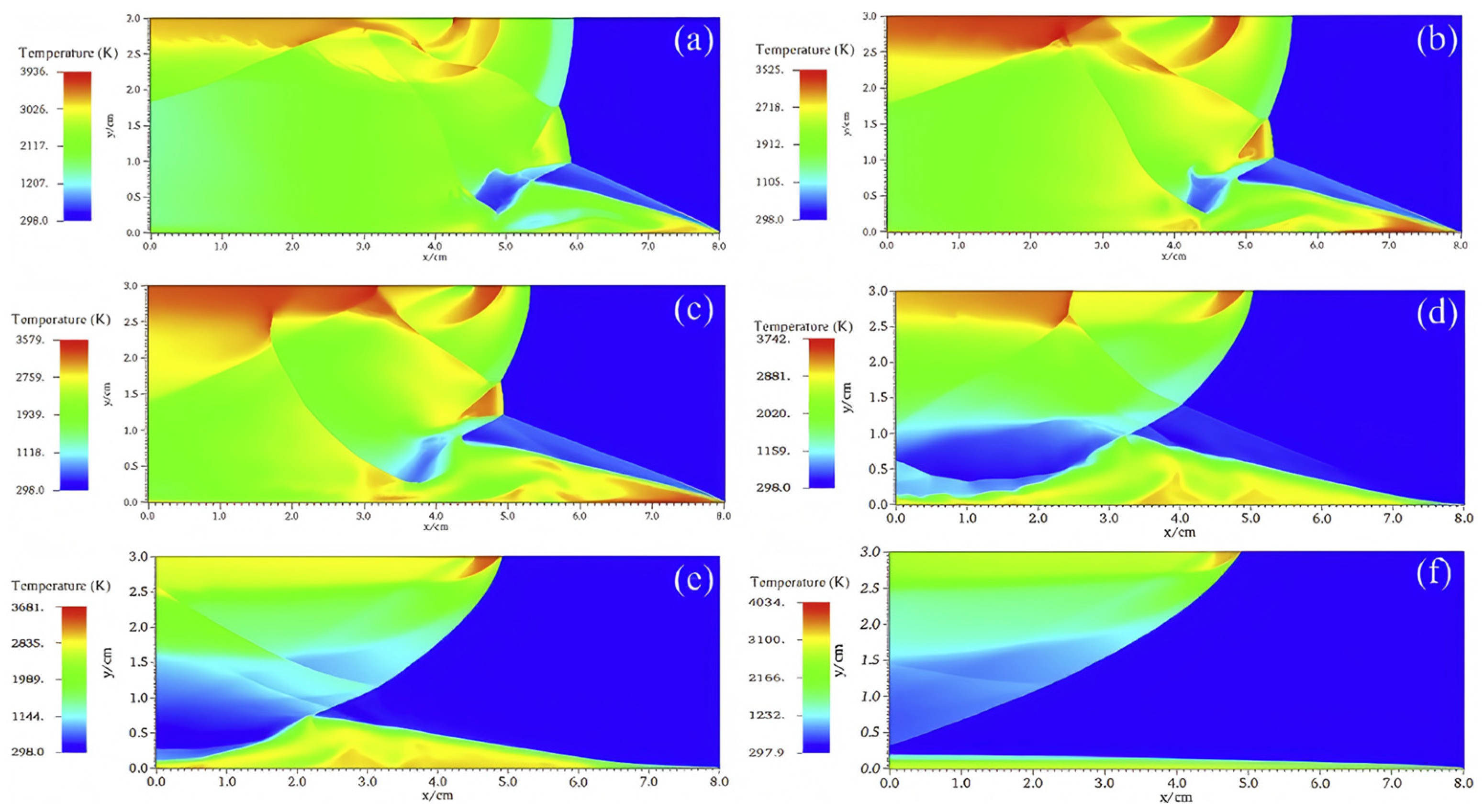

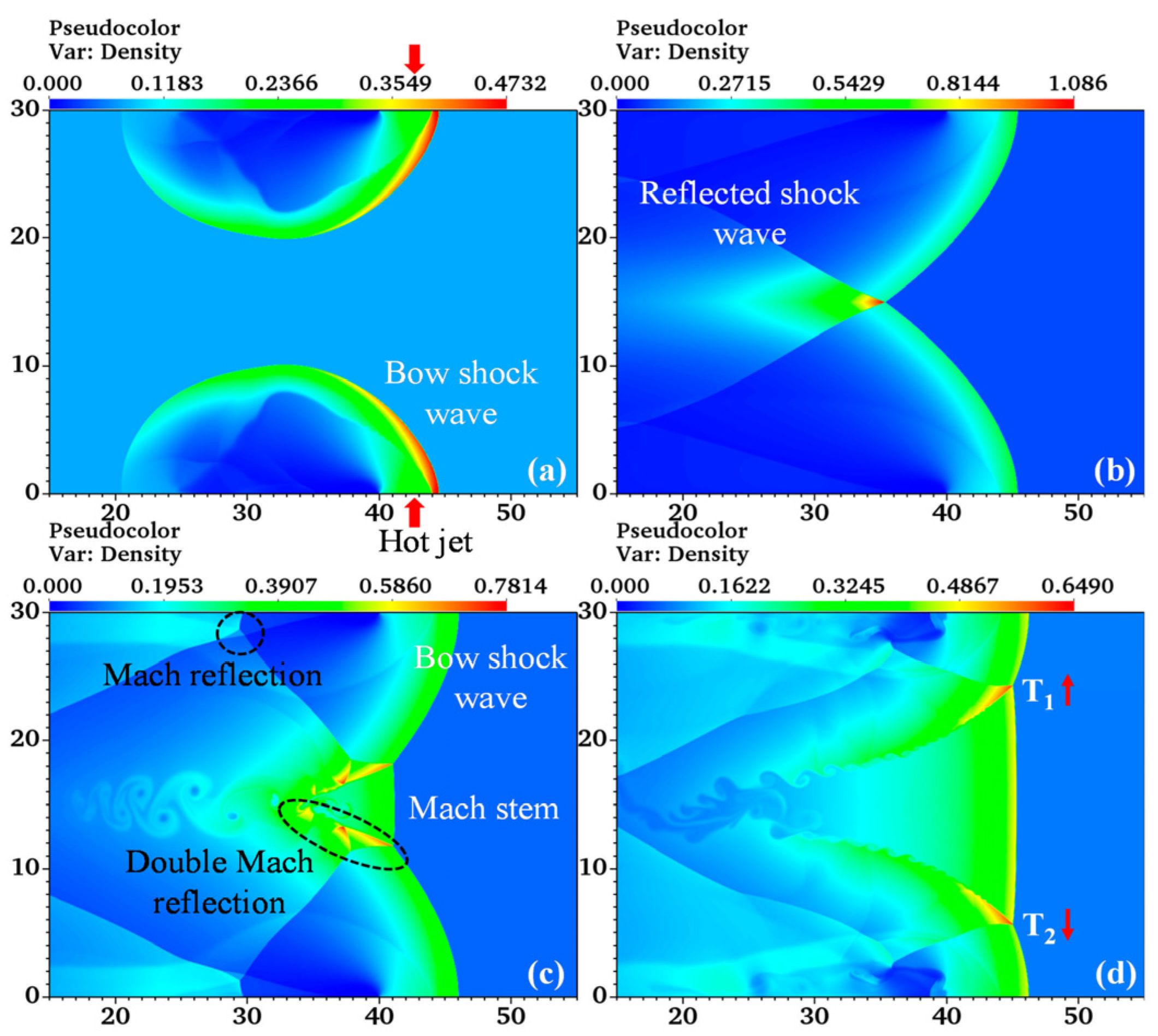





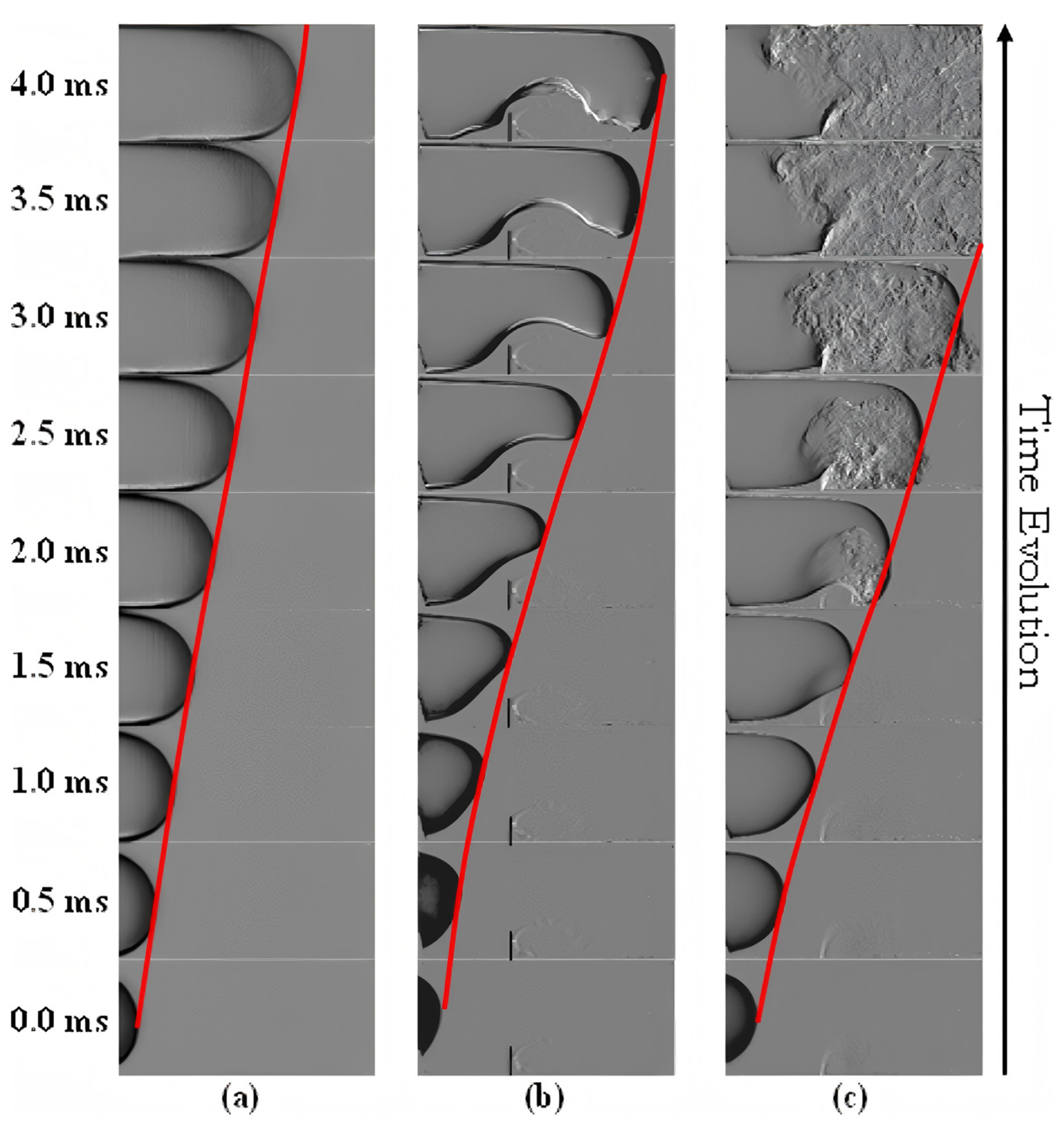



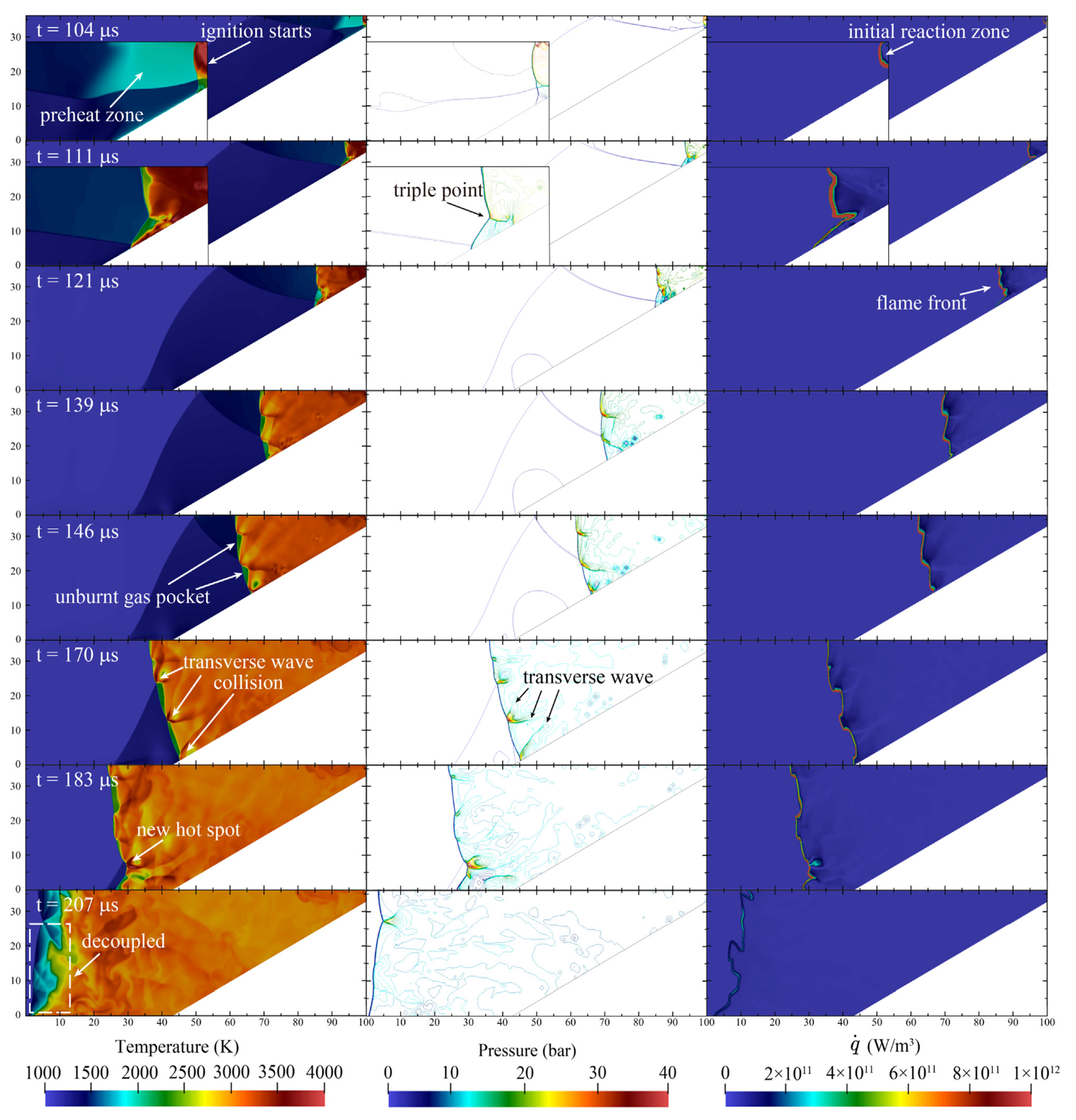



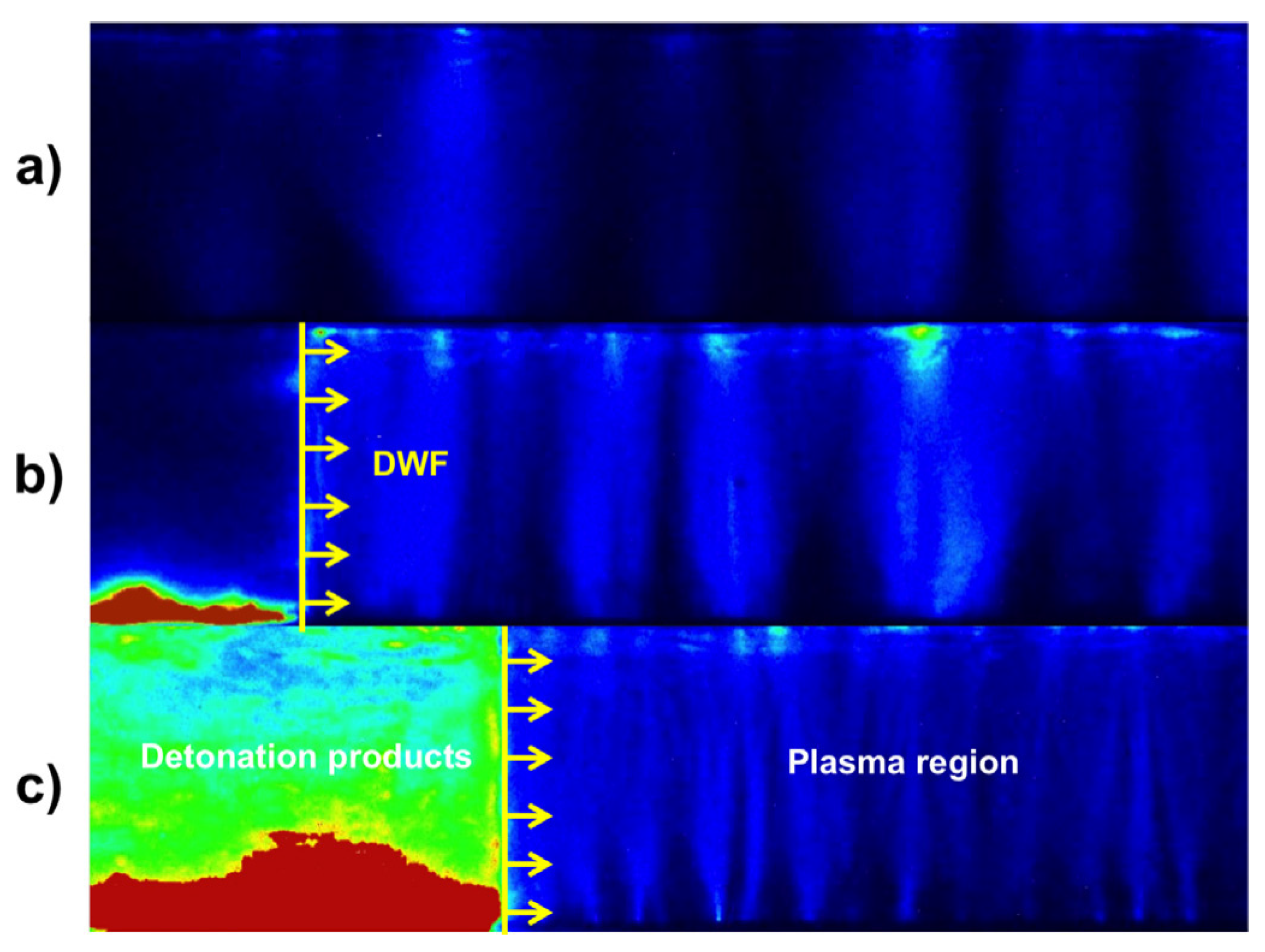
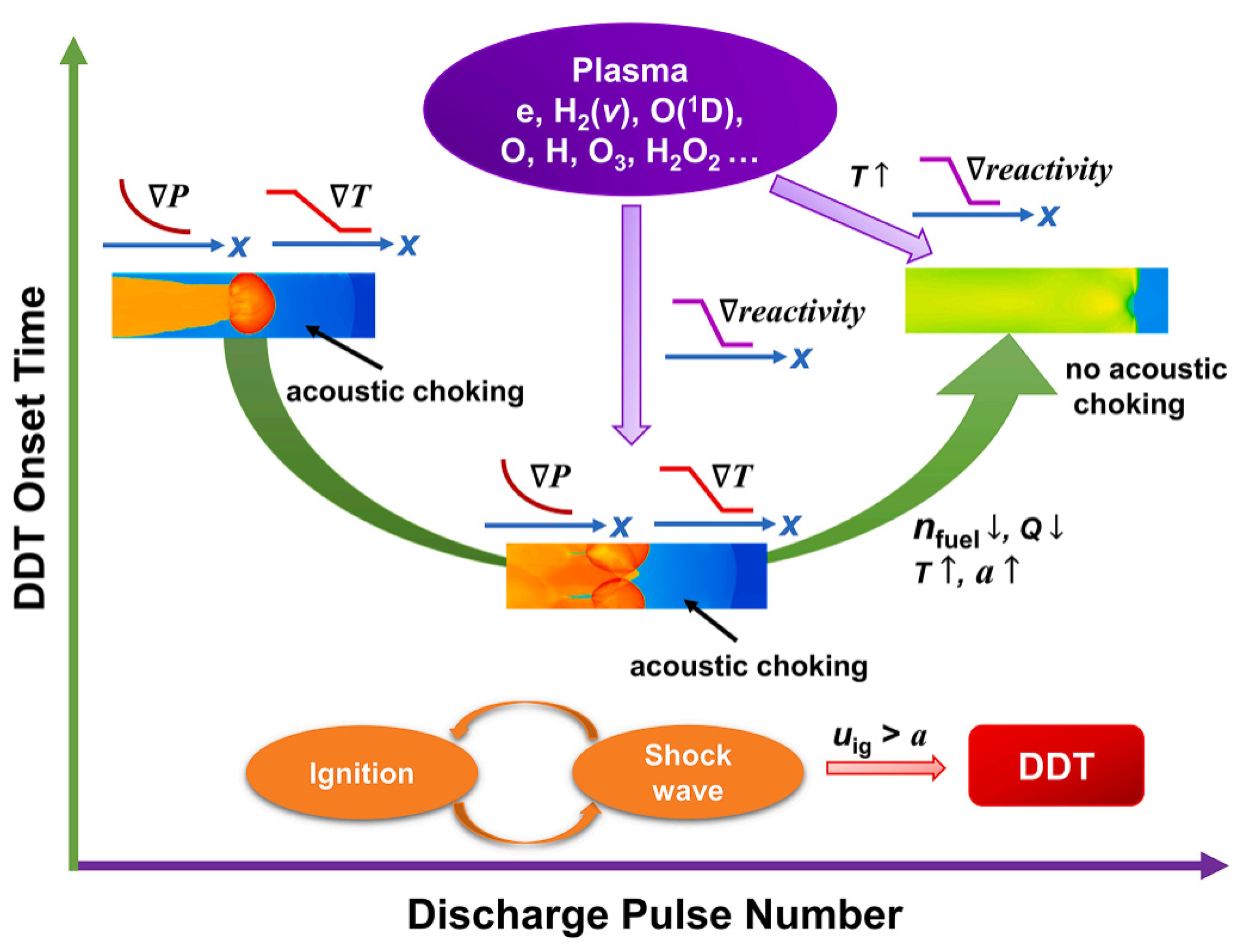
Disclaimer/Publisher’s Note: The statements, opinions and data contained in all publications are solely those of the individual author(s) and contributor(s) and not of MDPI and/or the editor(s). MDPI and/or the editor(s) disclaim responsibility for any injury to people or property resulting from any ideas, methods, instructions or products referred to in the content. |
© 2025 by the authors. Licensee MDPI, Basel, Switzerland. This article is an open access article distributed under the terms and conditions of the Creative Commons Attribution (CC BY) license (https://creativecommons.org/licenses/by/4.0/).
Share and Cite
Wang, Z.; Qin, W.; Wei, L.; Zhang, Z.; Hui, Y. Advances on Deflagration to Detonation Transition Methods in Pulse Detonation Engines. Energies 2025, 18, 2109. https://doi.org/10.3390/en18082109
Wang Z, Qin W, Wei L, Zhang Z, Hui Y. Advances on Deflagration to Detonation Transition Methods in Pulse Detonation Engines. Energies. 2025; 18(8):2109. https://doi.org/10.3390/en18082109
Chicago/Turabian StyleWang, Zhiwu, Weifeng Qin, Lisi Wei, Zixu Zhang, and Yuxiang Hui. 2025. "Advances on Deflagration to Detonation Transition Methods in Pulse Detonation Engines" Energies 18, no. 8: 2109. https://doi.org/10.3390/en18082109
APA StyleWang, Z., Qin, W., Wei, L., Zhang, Z., & Hui, Y. (2025). Advances on Deflagration to Detonation Transition Methods in Pulse Detonation Engines. Energies, 18(8), 2109. https://doi.org/10.3390/en18082109




